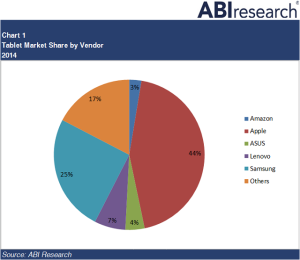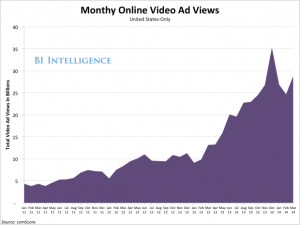Digital Video Ads, Facebook News, Tablet Sales, Hispanic Ad Spending, and more are among the topics covered in this month’s installment of TFP’s Media Metrics roundup.
To help you keep up with trends and prepare for changes just around the corner, each month we compile excerpts from some key reports covering issues affecting the publishing and media industries. Here are our top picks.
The Digital Video Ad Report: Growth Forecasts, Major Industry Players, and Viewability Scandals (Business Insider)
- A BI Intelligence report on the growth of video ads found online video ad revenue will hit nearly $5 billion in 2016, up from $2.8 billion last year. Meanwhile, TV ad revenue is expected to fall 3% annually during the same period.
- Video ad views rose to more than 35 billion in December 2013, averaging more than 100% monthly growth year over year.
- The average click-through rate of video ads is 1.84%, the highest rate of all digital ad formats.
- While online video ads are more expensive than other formats, the report said prices are expected to steadily decline as more publishers move toward video and placements open up.
Facebook Delivers News to 30% of U.S. Adults (ReadWrite)
- Pew Research found that almost half of U.S. Facebook users, which is nearly 30% of the general population, find news via the social networking site.
- Only 28% of those users follow breaking news, however. Instead, entertainment and community news are the most popular subjects, while international news, science and technology, and business get the least amount of traffic.
- In comparison, one-sixth of U.S. adults use Twitter, and half of those users find news via the site.
- 50% of survey respondents use YouTube and view news reports on the site, and while only 3% use Reddit, the majority of those users (two-thirds) get news on the site.
Amazon Lags in Global Tablet Sales (Digital Book World)
- ABI Research projected that Amazon tablets, including two recently released Fire models, will make up only 3% of global tablet sales by the end of 2014, based on figures from the first three quarters.
- Amazon tablets came in a distant fifth, behind leaders Apple, which has a projected year-end market share of 44%, and Samsung, which stands at 25%.
- Overall tablets sales are expected to be slow, however, with only 2.5% growth, according to ABI Research.
CIO Survey Shows PC Spending a ‘Low Priority’ While Tablets Gain in the Enterprise (TabTimes)
- Despite projections for sluggish tablet sales this year, a Barclays survey of 100 CIOs in the U.S. and Europe found that 97 of the respondents are considering or already using tablets in the enterprise.
- The percentage of CIOs already deploying tablets is up from earlier this year (68%), while 21% of survey respondents reported that they are trialing the devices.
- The survey also found that a large number of respondents believe tablet deployments are “key” within their organizations, with Apple being the vendor of choice, followed by Microsoft.
- The CIOs noted that PCs are among their lowest spending priorities, and according to the study, the market is expected to further contract this year.
- Some 48% of respondents indicated that tablets would replace standalone hardware purchases, while about 30% said tablets would replace laptops.
Hispanic Ad Spending is En Fuego (Media Life Magazine)
- While U.S. ad spending in general was up by only 3.1% in the first half of the year, revenue for Spanish-language media (TV, radio, magazines, and newspapers) jumped by 25%, to $4.312 billion, a report from Kantar Media showed. Hispanic media now makes up about 5% of total ad spending in the U.S., it said.
- Television, which makes up nearly 90% of Spanish-language advertising, saw a spike in the first half of the year with the airing of the World Cup: Spending increased almost 31%, to $3.88 billion, up from $2.975 billion in the same period last year.
- Other Spanish-language media to see gains was magazines, which grew 1.9% in the first half, to $121.6 million. The report noted that the Spanish-language magazine market is expanding, including the recent launch of Playboy Latino and a new parenting title from Meredith.
- There were declines among other media, however. Radio was down 10.3%, and newspapers declined 2.2%.
Mobile Video has Jumped 400% in the Last Two Years (Adweek)
- Another study of video use, conducted by Ooyala, found that 25% of online video is now via mobile devices, a 400% increase compared with two years ago.
- The research, which looked at the behaviors of almost 150 million viewers worldwide across billions of daily video interactions, also found that shorter is better, with 45% of mobile videos being six minutes or less.
- Longer videos (more than 10 minutes) were watched on bigger screens: Tablets were used 23% of the time to view videos 30 to 60 minutes long, and smart TVs were used 65% of the time for 30-minute videos and 54% of the time for 60-minute videos.
- Interestingly, weather played a role in online video viewing. The report said that in rainy weather, users spent 40% of the time viewing video on desktops, while they watched six times more videos when it was warm outside, suggesting that when the weather is good, people watch shorter clips on mobile.
The U.S. Accounts for 41.5% of all Mentions on Twitter (AllTwitter)
- More than 40% of all mentions on Twitter take place in the U.S., according to an analysis by Mention. The U.K. came in second with 9.7% of mentions, and France was third at 5.4%.
- The study, which looked at 70 million mentions from 234 different countries in a two-month period, also found that most mentions in the U.S. happen around 3 p.m. GMT, whereas in Europe, mentions start as early as 5 a.m.
- The most positive Twitter mentions take place in Spain, New Zealand, and Mexico, and English remains the most popular language on Twitter, ranking first or second in most countries.
New Nielsen Study Underscores Need for Diversity (BlackPressUSA)
- 87% of Black participants in a recent Nielsen study on diversity said acknowledgment of racial identity in advertisements is important, compared with 59% of the general population.
- The study also found that Black respondents were 38% more likely to make a purchase when an ad included Black people, and they were 43% more likely to do business with minority-owned companies.
- In addition, 45% of Black people with annual incomes above $50,000 said they have read a Black-focused magazine in the past month, and they interact with more media than average, especially Black-centric radio, magazines, and television.
Mobile Advertising is Outstripping Growth in TV, Radio, and All Digital Ad Mediums, Many Times Over
(Business Insider)
- Mobile, social media, and digital video spending is expected to drive U.S. digital ad revenue to more than $50 billion in 2014, and that number is projected to be more than $82 billion in 2018, according to a BI Intelligence report.
- Mobile ads will see the most growth. Mobile ad revenue, which includes mobile search ads, mobile web and in-app display ads, and video ads on mobile, is projected to reach $32.6 billion in 2018, with a five-year compound annual growth rate of 49.7%.
- The report also noted that social media ads on desktop and mobile will grow faster than other formats.
Could it be That Newspapers Still Matter? (Capital New York)
- According to a recent study by the Newspaper Association of America, 79% of respondents had “taken action as a result of reading or seeing an ad in a print newspaper in the past 30 days.”
- In addition, 57% of the 1,527 U.S. adults the association surveyed had used newspapers for shopping-related purposes in the past seven days; 52% used a print newspaper while 21% used a newspaper website.
- Almost two-thirds of respondents said they “look at or read advertisements as they go through the newspaper,” and 69% said they look for coupons in newspapers.
The 2014 City & Regional Magazine Survey (Folio)
- “Print still pays the bills” at local and regional publishers, according to a survey from Folio that shows that print makes up as much as 93% of their revenue.
- The survey also found that the ratio of print to non-print revenue is just a few points off from 10 years ago, and that more print assets are expected to launch in 2014 than at any point in the past five years.
- But smaller magazines expect print ad revenue as a percentage of overall earnings to decline slightly this year (3%). The report said that while that percentage isn’t significant, it could signal a trend.
- In print’s place, smaller publishers expect paid subscriptions, digital media, and events to increase year over year by at least 15% each.
Pew: Millennials Acknowledge Offline World (Media Life Magazine)
- While a Pew Research study not surprisingly found that 98% of those under the age of 30 use the Internet and 90% of those users are on social networking sites, it also revealed that they are more likely than older generations to acknowledge that important information is not available on the Internet (62% vs. 53%).
- In addition, the study, which looked at library, Internet, and other technology use among generational groups in the U.S., found that 77% of young adults have a smartphone, while 38% have a tablet and 24% use e-readers.
- Millennials also read more books than older adults in the past year (88% vs. 79%), and they do as much e-reading as those who are 30 to 40 years old, with 37% saying they have read an e-book in the past year.
- Millennials and older generations were almost equal in terms of library use in the past 12 months (50% vs. 47%), with the younger group more likely to have used a library website (36% vs. 28%). But the study also found that millennials are the least likely to say that their library’s closing would have a major impact on them compared with older adults (19% vs. 32%).
Media Metrics is a monthly feature from Technology for Publishing, aimed at keeping you armed with the latest industry data. If you’d like to share something you’ve read, drop us a note. And keep up with the latest industry news coverage by signing up for our This Week in Publishing emails or our monthly Publishing Trends newsletter.
Posted by: Margot Knorr Mancini



